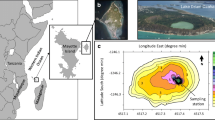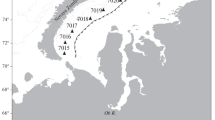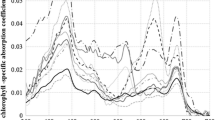Abstract
Unicellular autofluorescent picoplankton ranging from 0.4 to 1.5 µm in diameter were found to be a significant component of phytoplankton in the North Basin of Lake Biwa during early summer in 1989 and 1990. The abundance of these picoplankton varied seasonally by about three orders of magnitude with one maximum of up to 106 cells ml−1. Bloom-forming picoplankton were isolated by dilution and further cultivated in liquid medium. Three clones were found to be representative species of the bloom. Using epifluorescence and electron microscopy as well as absorption and fluorescence emission spectroscopy, we examined these clones according to shape and pigment composition. They have ringlike thylakoids, are photosynthetically active and have no nuclear envelope. The cyanobacterial clones isolated represent three types containing phycobilisomes with either phycocyanin or phycoerthrin as the dominant accessory pigment. They are described here as three new species, two phycoerythrin-rich types and one phycocyanin-rich type, all of them belonging to the Synechococcus group. The differences found by fluorescence emission of isolated clones are discussed with respect to in situ strain identification.
Similar content being viewed by others
References
Bailey-Watts, A. E., M. E. Bindloss & J. H. Belcher, 1968. Freshwater Primary production by a blue-green alga of bacterial size. Nature 220: 1344–1345.
Craig, S. R., 1984. Productivity of algal picoplankton in a small meromictic lake. Verh. int. Ver. Limnol. 22: 351–354.
Craig, S. R., 1987. The disribution and contribution of picoplankton to deep photosynthetic layers in some meromictic lakes. Acta. Acad. Aboensis 47: 55–81.
Carr, N. G. & B. A. Whitton, 1982. The Biology of Cyanobacteria. Blackwell Scientific Publications, Oxford, 688 pp.
Caron, D. A., F. R. Pick & D. R. Lean, 1985. Chroococcoid cyanobacteria in Lake Ontario; vertical and seasonal distributions during 1982. J. Phycol. 21: 171–175.
Chang, T. P., 1980. Zwei neue Synechococcus-Arten aus dem Zurichsee. Schweiz. Z. Hydrobiol. 42: 247–254.
El Hag, A. G. D. & G. E. Fogg, 1986. The distribution of coccoid blue-green algae (cyanobacteria) in the Menai Straits and the Irish Sea. Br. Phycol. J. 21: 45–54.
Ernst, A., 1991. Cyanobacterial picoplankton from Lake Constance: isolation by fluorescence characteristics. J. Plankton Res. 13: 1307–1312.
Fahnensteil, G. L., L. Sicko-Goad, D. Scavia & E. F. Stoermer, 1986. Importance of picoplankton in Lake Superior. Can. J. Fish. aquat. Sci. 43: 235–240.
Fahnensteil, G. L. & D. Scavia, 1987. Dynamics of Lake Michigan phytoplankton: recent changes in surface and deep communities. Can. J. Fish. aquat. Sci. 44: 509–514.
Fay, P. & V. Baalen (eds), 1987. The Cyanobacteria. Elsevier, Amsterdam, 543 pp.
Fogg, G. E., 1986. Picoplankton. Proc. r. Soc. Lond. B 288: 1–30.
Fogg, G. E., W. D. P. Stewart, P. Fay & A. E. Walsby, 1973. The Blue-green Algae. Academic Press, London, New York, 459 pp.
Gibson, C. E. & R. V. Smith, 1982. Freshwater plankton, In N. G. Carr & B. A. Whitton (eds), The Biology of Cyanobacteria. Blackwell Scientific Publications, Oxford: 464–489.
Glazer, A. N., 1987. Pyhcobilisomes: assembly and attachment. In P. Fay & V. Baalen (eds), The Cyanobacteria. Elsevier, Amsterdam: 69–94.
Glazer, A. N., 1988. Pyhcobiliprteins. In L. Packer & A. N. Glazer (eds), Methods in Enzymology, 167. Academic Press, New York: 291–303.
Hilton, J., E. Rigg & G. Jaworski, 1988. In vivo algal fluorescence, spectral change due to light intensity changes and the automatic characterization of algae. Freshwat. Biol. 20: 375–382.
Horie, S., 1961. Paleolimnological problems of Lake Biwa-ko. Memories of the College of Science, University of Kyoto, Series B (biology) 28: 53–71.
Johnson, W. P. & J. M. Sieburth, 1979. Chroococcoid cyanobacteria in the sea: a ubiquitous and diverse phototrophic biomass. Limnol. Oceanogr. 24: 928–935.
Joint, I. R., N. J. P. Owens & A. J. Pomroy, 1986. Seasonal production of photosynthetic picoplankton and nanoplankton in Celtic Sea. Mar. Ecol. Prog. Ser. 20: 113–118.
Krempin, D. W. & C. F. Sullivan, 1981. The seasonal abundance, vertical distribution, and relative microbial biomass of chroococcoid cyanobacteria at a station in southern California coastal waters. Can. J. Microbiol. 27: 1341–1344.
Murphy, L. S. & E. M. Haugen, 1985. The distribution and abundance of picoplanktonic ultraplankton in the north Atlantic. Limnol. Oceanogr. 30: 47–58.
Nagata, T., 1986. The seasonal abundance and vertical distribution of the < 3 µM phytoplankton in the north basin of Lake Biwa. Ecol. Res. 1: 207–221.
Nagata, T., 1988. The microflagellate-Picoplankton food linkage in the water column of Lake Biwa. Limnol. Oceanogr. 33: 504–517.
Nagata, T., 1990. Contribution of picoplankton to the grazer food chain of Lake Biwa. In M. Tilzer & C. Serruya (eds), Large Lakes. Springer-Verlag, Heidelberg: 526–539.
Nishizawa, K. & M. Chihara (eds), 1979. Methods in phycological studies (in Japanese). Kyouritu shuppan, Tokyo, 295–305.
Packer, L. & A. N. Glazer (eds), 1988. Methods in enzymology, 167. Academic Press, New York, 915 pp.
Pollingher, U., 1990. Effects of latitude on phytoplankton composition and abundance in large lakes. In M. Tilzer & C. Serruya (eds), Large Lakes. Springer-Verlag, Heidelberg: 368–402.
Scavia, D. & G. A. Laird, 1987. Bacterioplankton in Lake Michigan: dynamics, controls, and significance to carbon flux. Limnl. Oceanogr. 32: 1017–1033.
Schubert, H., U. Schiewer & E. Tschierner, 1989. Fluorescence characteristics of cyanobacteria (blue-green algae). J. Plankton Res. 11: 353–359.
Spurr, A. R., 1969. A low-viscosity epoxy resin embedding medium for electron microscopy. J. Ultrastruct. Res. 26: 31–43.
Stanier, R. Y., R. Kunisawa, M. Mandel & G. Cohen-Bazire, 1971. Purification and properties of unicellar blue-green algae (order chroococcales). Bact. Rev. 35: 171–205.
Steenbergen, C. L. M. & H. J. Korthals, 1982. Distribution of phototrophic microorganisms in the anaerobic and microaerophilic strata of Lake Vechten (The Netherlands). Pigment analysis and role in primary production. Limnol. Oceanogr. 27: 883–895.
Stockner, J. G. & N. J. Antia, 1986. Algal picoplankton from marine and freshwater ecosystems: a multidisciplinary perspective. Can. J. Fish. aquat. Sci. 43: 24772–2503.
Stockner, J. G., 1988. Phototrophic picoplankton: An overview from marine and freshwater ecosystems. Limnol. Oceanogr. 33: 765–775.
Tsuji, T., K. Ohki & Y. Fujita, 1986. Determination of photosynthetic pigment composition in an individual phytoplankton cell in seas and lakes using fluorescence microscopy; properties of the fluorescence emitted from picoplankton cells. Mar. Biol. 93: 343–349.
Waterbury, J. B. & R. Rippka, 1989. Subsection I. Order Chroococcales Wettstein 1924, emend. Rippka et al., 1979. In Bergey's Manual of Systematic Bacteriology, Vol. 3, 1728–1746.
Weisse, T., 1988. Dynamics of autotrophic picoplankton in Lake Constance. J. Plankton Res. 10: 11779–1188.
Weisse, T. & H. Müller, 1990; Significance of heterotrophic nanoflagellates and ciliates in large lakes: Evidence from Lake Constance. In M. Tilzer & C. Serruya (eds), Large Lakes. Springer-Verlag, Heidelberg: 540–555.
Weisse, T. & A. Schweitzer, 1991. Seasonal and internal variation of autotrophic picoplankton in a large prealpine lake (Lake Constance). Ver. Int. Ver. Limnol. Proceedings of the 24th SIL congress, Munich, 1991; in press.
Wood, A. M., P. K. Horan, K. Miurhead, D. A. Phinney, C. M. Yentsch & J. B. Waterbury, 1985. Discrimination between types of pigments in marine Synechococcus spp. by scanning spectroscopy, epifluororescence microscopy and flow cytometry. Limnol. Oceanogr. 30: 1303–1315.
Author information
Authors and Affiliations
Rights and permissions
About this article
Cite this article
Maeda, H., Kawai, A. & Tilzer, M.M. The water bloom of Cyanobacterial picoplankton in Lake Biwa, Japan. Hydrobiologia 248, 93–103 (1992). https://doi.org/10.1007/BF00006077
Received:
Revised:
Accepted:
Issue Date:
DOI: https://doi.org/10.1007/BF00006077




